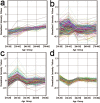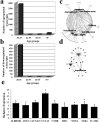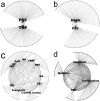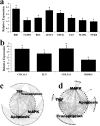Transcriptome analysis of human ageing in male skin shows mid-life period of variability and central role of NF-κB
- PMID: 27229172
- PMCID: PMC4882522
- DOI: 10.1038/srep26846
Transcriptome analysis of human ageing in male skin shows mid-life period of variability and central role of NF-κB
Abstract
Age is well-known to be a significant factor in both disease pathology and response to treatment, yet the molecular changes that occur with age in humans remain ill-defined. Here, using transcriptome profiling of healthy human male skin, we demonstrate that there is a period of significantly elevated, transcriptome-wide expression changes occurring predominantly in middle age. Both pre and post this period, the transcriptome appears to undergo much smaller, linear changes with increasing age. Functional analysis of the transient changes in middle age suggest a period of heightened metabolic activity and cellular damage associated with NF-kappa-B and TNF signaling pathways. Through meta-analysis we also show the presence of global, tissue independent linear transcriptome changes with age which appear to be regulated by NF-kappa-B. These results suggest that aging in human skin is associated with a critical mid-life period with widespread transcriptome changes, both preceded and proceeded by a relatively steady rate of linear change in the transcriptome. The data provides insight into molecular changes associated with normal aging and will help to better understand the increasingly important pathological changes associated with aging.
Figures




References
-
- Gosain A. & DiPietro L. Aging and wound healing. World J Surg. 28, 321–326 (2004). - PubMed
-
- Gogly B. et al.. Measurement of the amounts of elastic fibres in the skin and temporal arteries of healthy aged individuals by automated image analysis. Gerontology. 44, 318–323 (1998). - PubMed
-
- Kirkwood T. B. Understanding the odd science of aging. Cell 120, 437–447 (2005). - PubMed
-
- Hsin H. & Kenyon C. Signals from the reproductive system regulate the lifespan of C. elegans. Nature 399, 362–366 (1999). - PubMed
-
- Partridge L., Gems D. & Withers D. J. Sex and death: What is the connection? Cell. 120, 461–472 (2005). - PubMed
Publication types
MeSH terms
Substances
LinkOut - more resources
Full Text Sources
Other Literature Sources
Medical
Molecular Biology Databases
Miscellaneous

